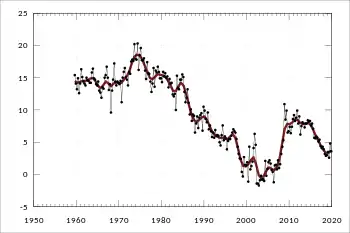Average propensity to save
In economics, the average propensity to save (APS), also known as the savings ratio, is the proportion of income which is saved, usually expressed for household savings as a fraction of total household disposable income. The ratio differs considerably over time and between countries. The savings ratio for an entire economy can be affected by (for example) the proportion of older people (as they have less motivation and capability to save), and the rate of inflation (as expectations of rising prices can encourage people to spend now rather than later).

The household savings ratio in Australia since 1959
The complement (1 minus the APS) is the average propensity to consume (APC).
See also
- Marginal propensity to save
- Marginal propensity to consume
- Golden Rule savings rate
- Kinetic exchange models of markets
This article is issued from Wikipedia. The text is licensed under Creative Commons - Attribution - Sharealike. Additional terms may apply for the media files.